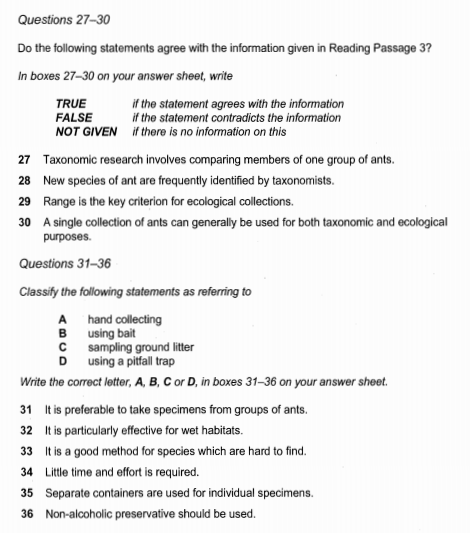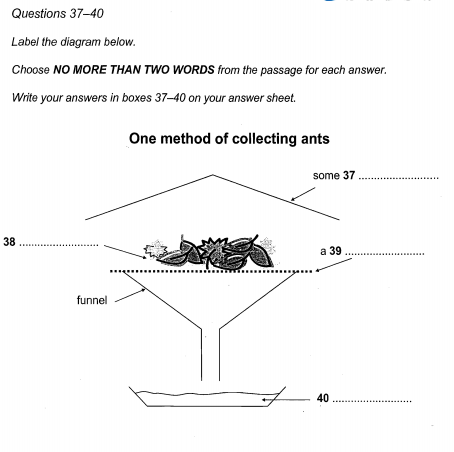剑桥雅思8阅读:Test4雅思阅读PASSAGE3真题+答案+解析
发布时间:2021-01-14 关键词:READING PASSAGE 3
Collecting Ant Specimens Collecting ants can be as simple as picking up stray ones and placing them in a glassjar, or as complicated as completing an exhaustive survey of all species present in anarea and estimating their relative abundances. The exact method used will depend onthe final purpose of the collections. For taxonomy, or classification, long series, froma single nest, which contain all castes (workers, including majors and minors, and, ifpresent, queens and males) are desirable, to allow the determination of variation withinspecies. For ecological studies, the most important factor is collecting identifiable samples of a5 many of the different species present as possible. Unfortunately, these methods are not always compatible. The taxonomist sometimes overlooks whole speciesin favour of those groups currently under study, while the ecologist often collects onlya limited number of specimens of each species, thus reducing their value for taxonomicinvestigations.
To collect as wide a range of species as possible, several methods must be used. Theseinclude hand ollecting, using baits to attract the ants, ground litter sampling, and the useof pitfall traps. Hand collecting consists of searching for ants everywhere they are likelyto occur. This includes on the ground, under rocks, logs or other objects on the ground,in rotten wood on the ground or on trees, in vegetation, on tree trunks and under bark.When possible, collections should be made from nests or foraging columns and at least20 to 25 individuals collected. This will ensure that all individuals are of the same specics,and so increase their value for detailed studies. Since some species are largely nocturnal,collecting should not be confined to daytime. Specimens are collected using an aspirator(often called a pooter), forceps, a fine, moistened paint brush, or fingers, if the ants areknown not to sting. Individual insects are placed in plastic or glass tubes (1.5-3.0 m capacity for small ants, 5- -8 ml for larger ants) containing 75% to 95% ethanol. Plastic tubeswith secure tops are better than glass because they are lighter, and do not break as easily ifmishandled.
Baits can be used to attrat and concentrate foragers. This often increases the number ofindividuals collected and attracts species that are otherwise clusive. Sugars and meats or oilswill attracat different specics and a range should be utilised. These baits can be placed citheron the ground or on the trunks of trecs or large shrubs. When placed on the ground, baitsshould be situated on small paper cards or other flat, light-coloured surfaces, or in test-tubesor vials. This makes it easier to spot ants and to capture them before they can escape intothe surrounding leaf littt Many ants are small and forage primarily in the layer of leaves and other debris on the ground. Collecting these specics by hand can be ifcult. One of the most successful waysto collect them is to gather the leaf litter in which they are foraging and extract the antsfrom it. This is most commonly done by placing leaf litter on a screen over a large funnel,often under some heat. As the leaf ltter drics from above, ants (and other animals) movedownward and cventually fall out the bottom and are ollected in alcohol placed belowthe funnel. This method works especially well in rain forests and marshy areas. A methodof improving the catch when using a funnel is to sift the leaf litter through a coarse screenbefore placing it above the funnel, This will concentrate the litter and remove larger leavesand twigs. It will also allow more itter to be sampled when using a limited number of funnels.
The pitfall trap is another commonly used tool for ollecting ants. A pitfal trap can be anysmall container placed in the ground with the top level with the surrounding surface andilled with a preservative. Ants are olleted when they fall into the trap while foraging.The diameter of the traps can vary from about 18 mm to 10 cm and the number uscd canvary from a few to several hundred, The size of the traps used is induenced largely bypersonal preference (although larger sizes are generally better), while the number willbe determined by the study being undertaken. The preservative used is usually ethyleneglycol or propyiene glycol, as alcohol will evaporate quickly and the traps will dry out.One advantage of pitfal traps is that they can be uscd to ollect over a period of time withminimal maintenance and intervention. Onc disadvantage is that some species are not collected as they cither avoid the traps or do not commonly encounter them while foraging.
收集蚂蚁犹如捡起一群走失的家畜并且把他们放在玻璃罐里一样简单,却又犹如对出现在 同一个区域所有物种完成一个详尽的调查并且估算出它们的相对数量般复杂。确切的使用方法 将取决于收集的最终目的。对于分类学或分类,在一个蚁窝里的一系列蚂蚁,包含了所有等级
(工蚁,包括主要的和次要的、蚁后和男蚁,如果有的话)对于决定物种间的不同是很有必要的。 对于生态学研究,最重要的因素是在所呈现的不同种类中收集尽可能多的可识别的样本。然而 不幸的是,这些方法经常难以兼容。分类学家有时由于专注眼下研究的种群而忽视了整个物种, 然而生态学家经常只在一个物种中收集有限数量的样品,因此减少了它们对于生态研究的价值。
为了尽可能大范围的收集蚂蚁的种类,我们可以用到一些方法。这些方法包括手工收集、用 诱饵去吸引蚂蚁、在地面上放一些废弃物、或者给蚂蚁设置陷阱。手工收集包括在蚂蚁可能出现 的任何地方搜寻蚂蚁。例如在地面上、岩石底下、原木底下或者地面上的其他物体底下,还可以 是腐烂的木头里,或者在树上、草木从中、树干上、还有树皮下。如果可能的话,也可以从蚂蚁的 窝里或对正在觅食的蚁群进行收集,这样至少可以收集到 20-25 只。这样可以确保所有的蚂蚁 都来自同一种类,因此增加了对它们进行详细研究的价值。由于一些种类的蚂蚁大部分都是在 夜间活动,因此收集不应只局限在白天。收集时可以用吸液器、钳子、沾湿了的刷子这些工具,或 者直接用手指,如果蚂蚁不叮人的话。蚂蚁被放置在塑料或者玻璃试管里(收集小蚂蚁使用容量 为 1.5-3.0ml 的试管 , 收集大蚂蚁应使用容量为 5-8ml 的 ),试管里面含有 75% 到 95% 的乙醇。 有安全顶部的塑料试管要好于玻璃试管,因为它们更轻,并且操作不当的时候也不宜破碎。
诱饵能够用来吸引和聚集觅食的蚂蚁。这样做经常可以增加收集蚂蚁的数量,同时也吸引 了本可能会躲避掉的种类。糖、肉或者油会吸引不同种类的蚂蚁,因此它们可以被使用。这些诱 饵可以放在地上或者树杆上,或者大的灌木丛中。当放在地上时,诱饵应放在小的纸质卡片上或 者其他扁平的、浅色的表面上,也可以放在试管里或者小玻璃瓶中。这样可以在蚂蚁逃进周围散 落的落叶之前更容易发现它们进而将它们捕获。
许多蚂蚁很小,主要在落叶层里或者地上的其他残骸当中觅食。手工收集这类蚂蚁是很困 难的。收集它们最成功的一种方法就是收拢它们正在觅食的树叶,然后将蚂蚁从里面抽取出来。 此类操作主要是将树叶置于加热漏斗上面的筛子上,当树叶经过上面的操作变干时,蚂蚁(和其 他动物)就会向下移动,从底部出来,最后被收集在漏斗下面的酒精里。这种方法在热带雨林里和湿地里尤其有效。使用漏斗时,一个捕获蚂蚁的方法就是在将树叶置于漏斗上面之前先 用粗孔筛将其过滤。此操作将把树叶集中起来,把大一些的叶子和细枝移除。这样还可以在有 限数量的漏斗上放置的树叶样品。
陷阱是收集蚂蚁经常用到的另一种方法,陷阱可以是地面上任何顶部是平面的涂有防腐剂 的小容器。当觅食的蚂蚁落入陷阱即被收集到。陷阱的直径在 18mm 到 10cm 之间,数量也在几 个到几百个之间。陷阱的大小大多因个人喜好而异(尽管大一些的尺寸一般会),然而数量由 正在进行的研究所决定。由于酒精会很快蒸发,陷阱也会变干,所以使用的防腐剂通常是乙二醇 或者丙二醇。陷阱的一个好处就是可以使用一个较长的时期,并且使用期只需要最小的维护和干 涉。弊端是由于一些种类可能会避开陷阱,或者在觅食时不经常遇到它们而不会被收集到。


文章结构
体裁:说明文
主要内容:收集蚂蚁物种。
结构:
第 1 段 :收集蚂蚁一般分为两类,取决于不同的需要。
第 2 段 :要想收集尽可多的蚂蚁需要采用的方法。
第 3 段 :介绍用诱饵来收集蚂蚁。
第 4 段 :介绍用落叶层收集蚂蚁。
第 5 段 :介绍用陷阱来收集蚂蚁。
师资点题剑桥雅思8阅读:
考题解析
Questions 27-30
题型归类 :TRUE/FALSE/NOT GIVEN
题目解析
题目编号 题目定位词 答案位置 题解
27 taxonomic research 首段第 3 句 TRUE 题目中说生物分类学研究涉及比较一 组蚂蚁的成员,文章说从一个单独的巢穴去 研究,两者一致。文章中的 taxonomy 对应题 目 中 的 taxonomic research,a single nest 对 应 one group of ants。
28 new species, taxonomists 首段末句 NOT GIVEN 题目说蚂蚁的新物种经常被 生物分类学所辨别,而文章并没有给出 new species 相关的信息。
29 range, criterion 首段第 4 句 TURE 题目说范围对于生态收集是一个关键 的标准,文章中说对于生态学研究而言,最重 要的因素是尽可能多的去收集不同的可认知的 物种,题目与原文表述一致。其中文章中的 as many of different species as possible 对 应 题 目 中的 range, the most important factor 对应 the key criterion。
30 single collection 首段倒数第 2 句 FALSE 题目说一个单独的蚂蚁收集通常可以 同时为生物分类学目的和生态学目的所使用, 而文章说不幸的是这些方式不总是能够共存 的,题目的表述与原文相矛盾。
师资点题剑桥雅思8阅读:
考题解析
Questions 31-36
题型归类 :Matching
题目解析
题目编号 原文定位 题解
题目关键词 preferable, take specimens from group of ants 第二段第 5 句 答案A 根据关键词定位到第二段第5句,文 章说如果可能的话,收集应从巢穴开始,并 且至少要收集 20-25 个个体。这种收集方式 对应的名字出现在这句话之前,我们向前寻 找即可找到 hand collecting。
32 effective, wet habitats 第四段倒数 第3句 答案 C 题目实际考查的是哪种方法在湿润 的栖息地比较有效,根据题目关键词可定 位到第四段倒数第 3 句,其中文章中的 rain forests and marshy areas 对 应 题 目 中 的 wet habitats。原文第四段主要是描述 sampling ground litter 这种方法,而这种方法适用于 雨林和沼泽地等湿润地区。
33 hard to find 第三段第 2 句 答案 B 题目意思是“对于那些难以找到的
品种来说是个的方法”,原文说用诱饵 (baits)可以吸引那些不易找到的物种,其中 文章中的 elusive 对应题目中的 hard to find。
34 little time and effort 第五段倒数 第2句 答案 D 题目实际考查的是哪种方式需要的 时间和努力比较少,原文说 One advantage of pitfall traps is that they can be used to collect over a period of time with minimal maintenance and intervention, 由 此 可 知 using a pitfall trap 为正确答案。
35 separate containers, individual specimens 第二段倒数 第2句 答案A 题目实际考查的是哪种方式用不同的 容器收集个体,文章说 Individual insects are placed in plastic or glass tubes... 这仍是 hand collecting 的做法。
36 non-alcoholic preservative 第五段倒数 第3句 答案D 题目实际考查的是哪种方式必须使用 不含酒精的防腐剂,文章说 the preservative used is usually ethylene glycol or propylene glycol, as alcohol will evaporate quickly and the traps will dry out, 对 应 的 是 pitfall trap 这种方法。
师资点题剑桥雅思8阅读:
考题解析
Questions 37-40
题型归类 :Diagram
题目解析
题目编号 题目关键词 原文定位 题解
37-40 funnel 第四段中 间部分 文 章 中 说 This is most commonly done by placing leaf litter on a screen over a large funnel, often under some heat. As the leaf litter dries from above, ants move downward and eventually fall out the bottom and are collected in alcohol placed below the funnel。根据文章描述,37 题答案为 heat, 38 题答案为 leaf litter, 39 题答案为 screen, 40 题答案 为 alcohol。




